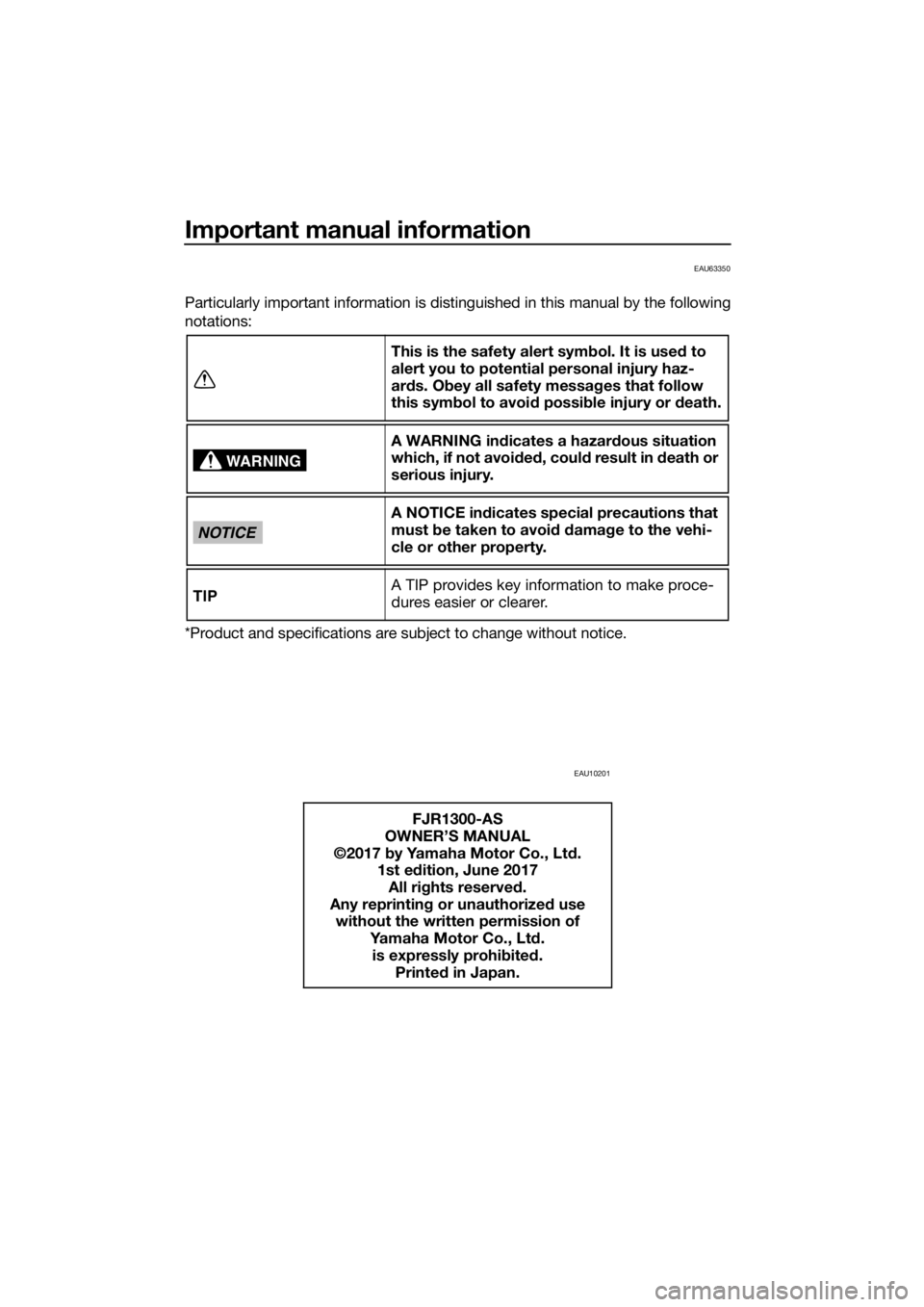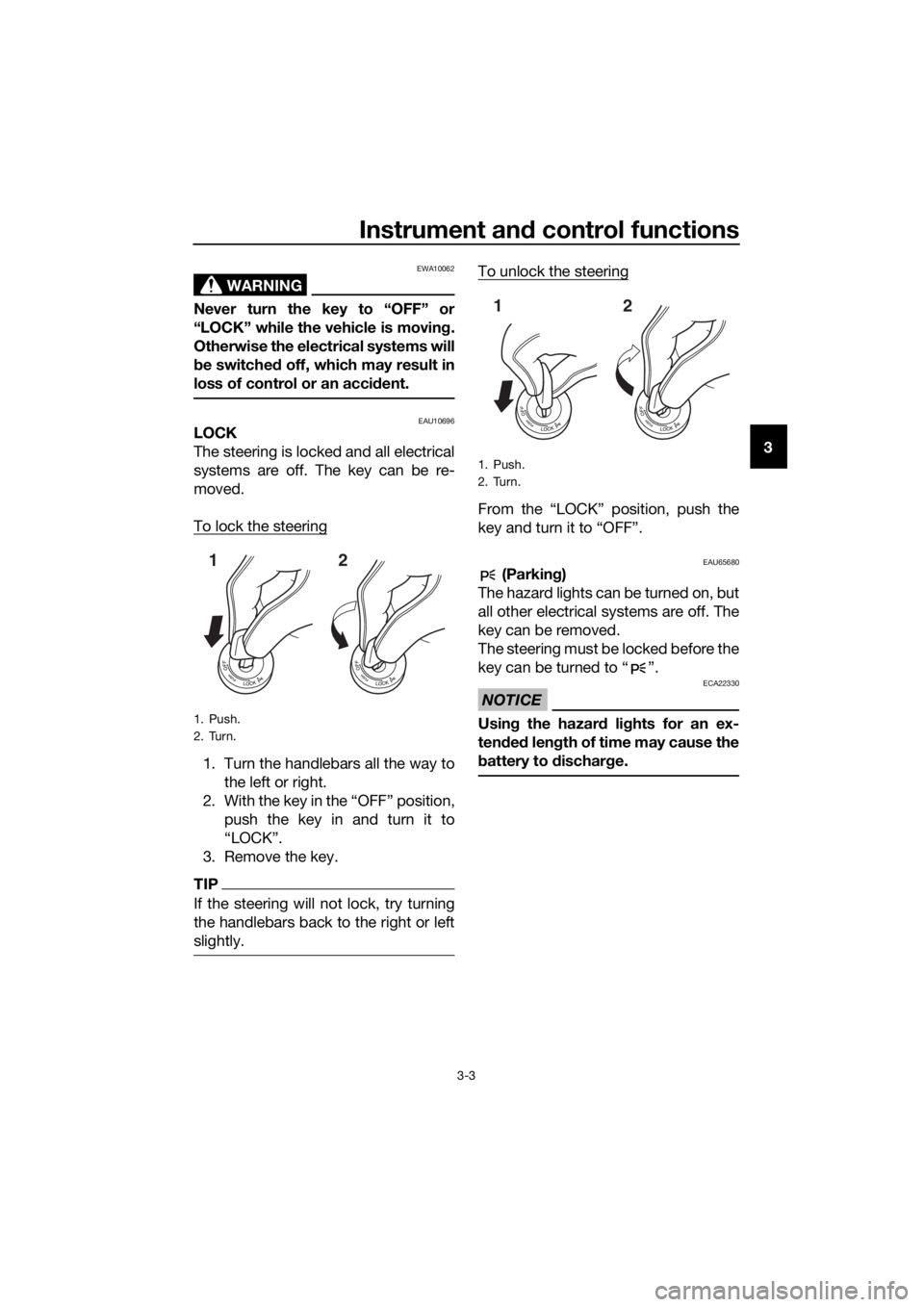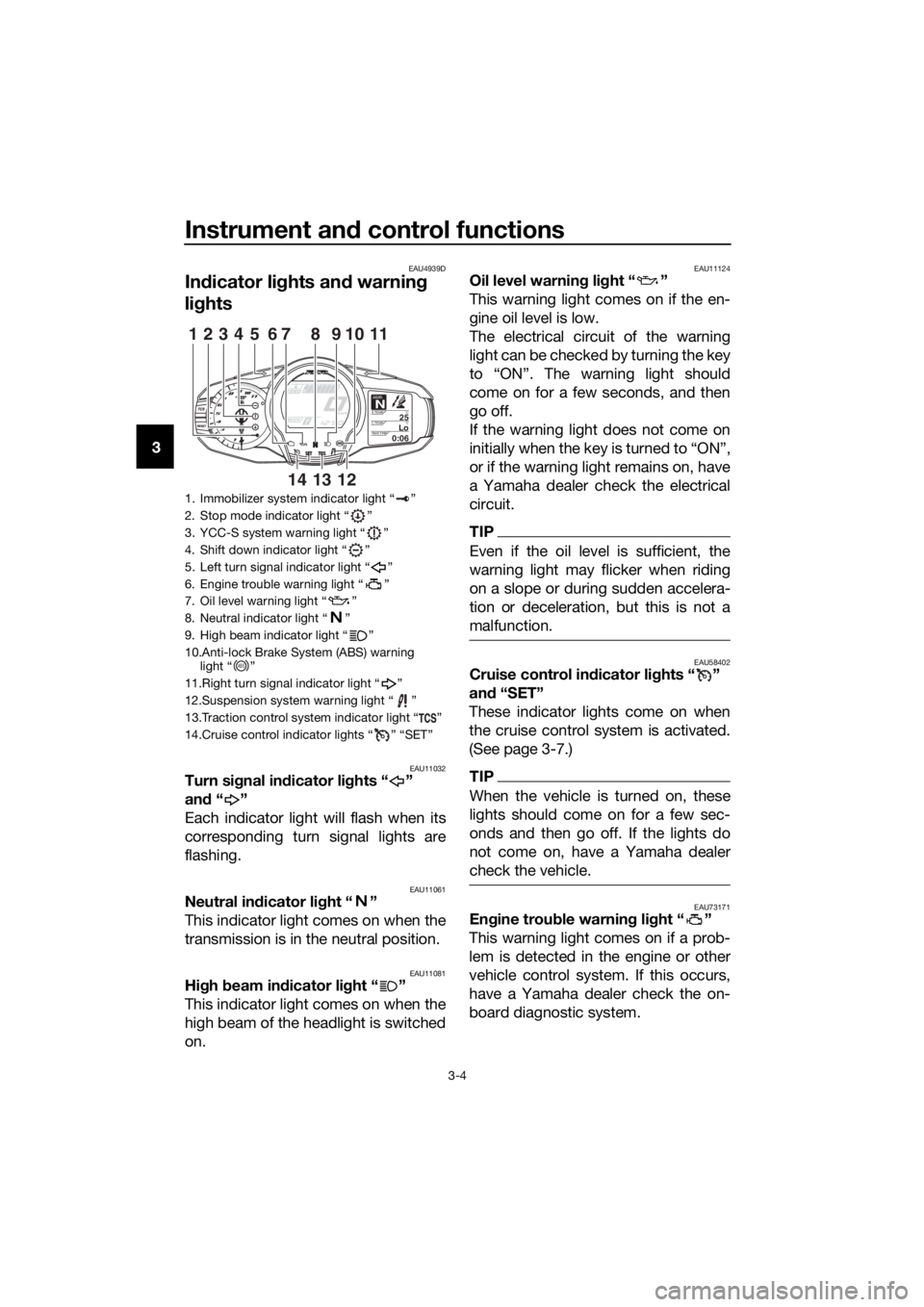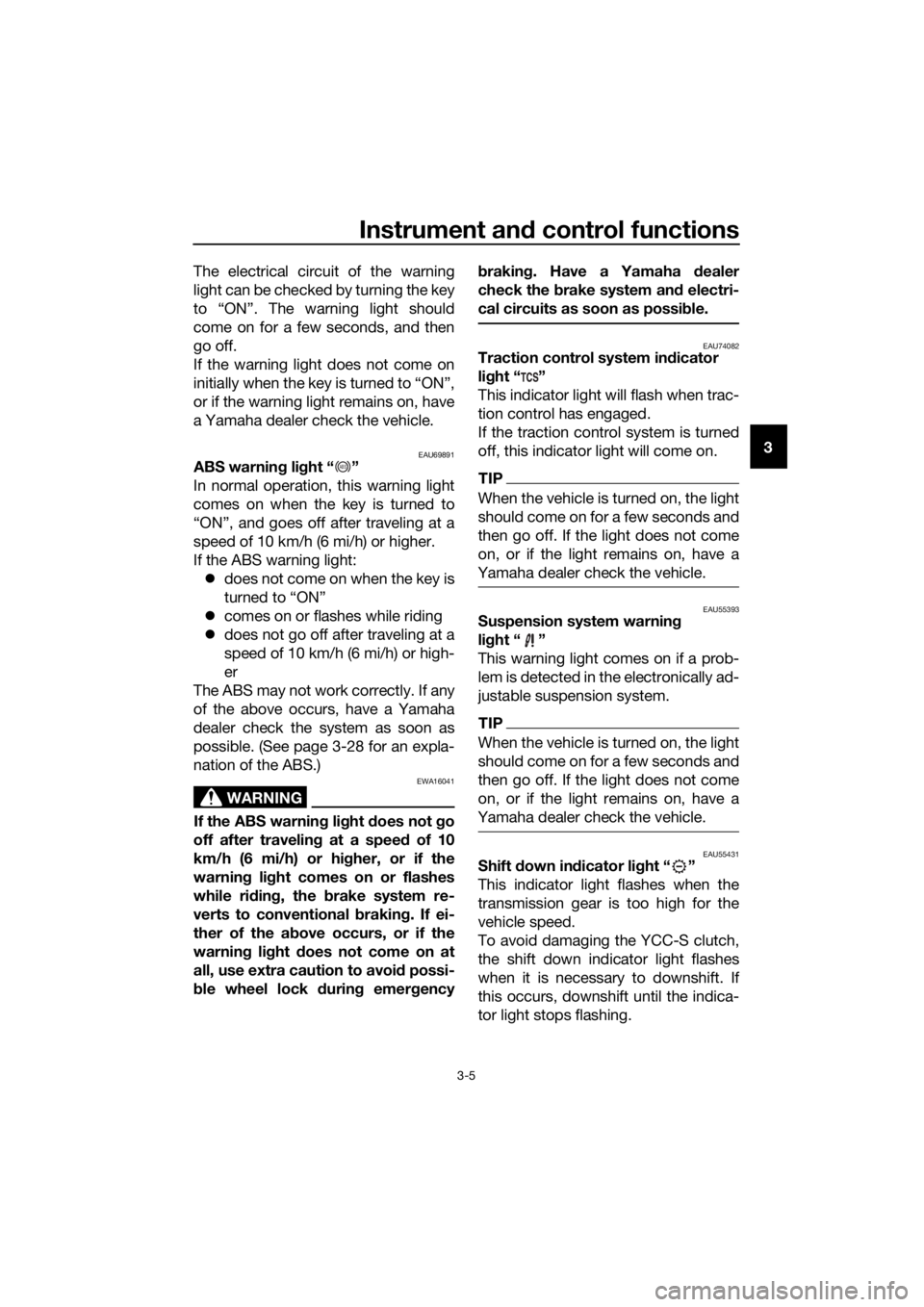warning YAMAHA FJR1300AS 2018 Owners Manual
[x] Cancel search | Manufacturer: YAMAHA, Model Year: 2018, Model line: FJR1300AS, Model: YAMAHA FJR1300AS 2018Pages: 122, PDF Size: 3.48 MB
Page 3 of 122

Introduction
EAU10103
Welcome to the Yamaha world of motorcycling!
As the owner of the FJR1300-AS, you are benefiting from Yamaha’s vast experi-
ence and newest technology regarding the design and manufacture of high-qual-
ity products, which have earned Yamaha a reputation for dependability.
Please take the time to read this manual thoroughly, so as to enjoy all advantages
of your FJR1300-AS. The Owner’s Manual does not only instruct you in how to
operate, inspect and maintain your motorcycle, but also in how to safeguard your-
self and others from trouble and injury.
In addition, the many tips given in this manual will help keep your motorcycle in
the best possible condition. If you have any further questions, do not hesitate to
contact your Yamaha dealer.
The Yamaha team wishes you many safe and pleasant rides. So, remember to put
safety first!
Yamaha continually seeks advancements in product design and quality. There- fore, while this manual contains the most current product information available at
the time of printing, there may be minor discrepancies between your motorcycle
and this manual. If there is any question concerning this manual, please consult a
Yamaha dealer.
WARNING
EWA10032
Please rea d this manual carefully an d completely before operating this mo-
torcycle.
UB95E1E0.book Page 1 Tuesday, September 26, 2017 12:01 PM
Page 4 of 122

Important manual information
EAU63350
Particularly important information is distinguished in this manual by the following
notations:
*Product and specifications are subject to change without notice.
EAU10201
This is the safety alert symbol. It is use d to
alert you to potential personal injury haz-
ar ds. O bey all safety messag es that follow
this symb ol to avoid possi ble injury or death.
A WARNING in dicates a hazar dous situation
which, if not avoi ded , coul d result in d eath or
serious injury.
A NOTICE in dicates special precautions that
must be taken to avoi d d amag e to the vehi-
cle or other property.
A TIP provides key information to make proce-
dures easier or clearer.
FJR1300-AS
OWNER’S MANUAL
©2017 by Yamaha Motor Co., Lt d.
1st e dition, June 2017
All ri ghts reserve d.
Any reprintin g or unauthorize d use
without the written permission of
Yamaha Motor Co., Ltd .
is expressly prohi bite d.
Printe d in Japan.
WARNING
NOTICE
TIP
UB95E1E0.book Page 1 Tuesday, September 26, 2017 12:01 PM
Page 5 of 122

Table of contents
Safety information ............................1-1
Description ........................................2-1
Left view ..........................................2-1
Right view........................................2-2
Controls and instruments ................2-3
Instrument an d control functions ....3-1
Immobilizer system .........................3-1
Main switch/steering lock ...............3-2
Indicator lights and warning lights ............................................3-4
Cruise control system .....................3-7
Multi-function meter unit ...............3-10
D-mode (drive mode) ....................3-23
Handlebar switches.......................3-23
YCC-S system...............................3-25
Shift pedal .....................................3-26
Hand shift lever .............................3-27
Brake lever ....................................3-27
Brake pedal ...................................3-28
ABS ...............................................3-28
Traction control system.................3-29
Fuel tank cap.................................3-31
Fuel................................................3-31
Fuel tank overflow hose ................3-33
Catalytic converters .....................3-33
Seats .............................................3-34
Adjusting the rider seat height ......3-35
Storage compartment ...................3-37
Accessory box...............................3-38
Adjusting the headlight beams......3-39
Handlebar position ........................3-40
Opening and closing the cowling vents ..........................................3-40
Rear view mirrors ..........................3-42
Adjusting the front and rear suspension.................................3-42
Sidestand ......................................3-47
Ignition circuit cut-off system........3-47
Auxiliary DC jack ..........................3-49
Cornering lights .............................3-50 For your safety – pre-operation
checks
............................................... 4-1
Operation an d important ri din g
points ................................................. 5-1
Starting the engine.......................... 5-2
Shifting ............................................ 5-3
Tips for reducing fuel consumption................................ 5-4
Engine break-in ............................... 5-5
Parking ............................................ 5-6
Perio dic maintenance an d
a d justment ........................................ 6-1
Owner’s tool kit ............................... 6-2
Periodic maintenance chart for the emission control system.............. 6-3
General maintenance and lubrication chart........................... 6-4
Removing and installing panels ...... 6-7
Checking the spark plugs ............. 6-10
Canister......................................... 6-11
Engine oil and oil filter cartridge ... 6-11
Final gear oil.................................. 6-14
Coolant ......................................... 6-16
Air filter element ............................ 6-17
Checking the engine idling
speed......................................... 6-18
Checking the throttle grip free
play ............................................ 6-18
Valve clearance ............................. 6-19
Tires .............................................. 6-19
Cast wheels .................................. 6-22
YCC-S clutch ................................ 6-22
Checking the brake lever free play ............................................ 6-23
Brake light switches ...................... 6-23
Checking the front and rear brake pads........................................... 6-24
Checking the brake and YCC-S clutch fluid levels ....................... 6-25
Changing the brake and YCC-S clutch fluids ............................... 6-26
Checking and lubricating the cables ........................................ 6-27
UB95E1E0.book Page 1 Tuesday, September 26, 2017 12:01 PM
Page 7 of 122

1-1
1
Safety information
EAU1028C
Be a Responsible Owner
As the vehicle’s owner, you are re-
sponsible for the safe and proper oper-
ation of your motorcycle.
Motorcycles are single-track vehicles.
Their safe use and operation are de-
pendent upon the use of proper riding
techniques as well as the expertise of
the operator. Every operator should
know the following requirements be-
fore riding this motorcycle.
He or she should: Obtain thorough instructions from
a competent source on all aspects
of motorcycle operation.
Observe the warnings and mainte-
nance requirements in this Own-
er’s Manual.
Obtain qualified training in safe
and proper riding techniques.
Obtain professional technical ser-
vice as indicated in this Owner’s
Manual and/or when made neces-
sary by mechanical conditions.
Never operate a motorcycle with-
out proper training or instruction.
Take a training course. Beginners
should receive training from a cer-
tified instructor. Contact an autho-
rized motorcycle dealer to find out
about the training courses nearest
you.
Safe Ri din g
Perform the pre-operation checks
each time you use the vehicle to make
sure it is in safe operating condition.
Failure to inspect or maintain the vehi-
cle properly increases the possibility of an accident or equipment damage.
See page 4-1 for a list of pre-operation
checks.
This motorcycle is designed to
carry the operator and a passen-
ger.
The failure of motorists to detect
and recognize motorcycles in traf-
fic is the predominating cause of
automobile/motorcycle accidents.
Many accidents have been
caused by an automobile driver
who did not see the motorcycle.
Making yourself conspicuous ap-
pears to be very effective in reduc-
ing the chance of this type of
accident.
Therefore:
• Wear a brightly colored jacket.
• Use extra caution when you are approaching and passing
through intersections, since in-
tersections are the most likely
places for motorcycle accidents
to occur.
• Ride where other motorists can see you. Avoid riding in another
motorist’s blind spot.
• Never maintain a motorcycle without proper knowledge.
Contact an authorized motorcy-
cle dealer to inform you on ba-
sic motorcycle maintenance.
Certain maintenance can only
be carried out by certified staff.
UB95E1E0.book Page 1 Tuesday, September 26, 2017 12:01 PM
Page 17 of 122

Instrument and control functions
3-3
3
WARNING
EWA10062
Never turn the key to “OFF” or
“LOCK” while the vehicle is movin g.
Otherwise the electrical systems will
b e switche d off, which may result in
loss of control or an acci dent.
EAU10696LOCK
The steering is locked and all electrical
systems are off. The key can be re-
moved.
To lock the steering
1. Turn the handlebars all the way to
the left or right.
2. With the key in the “OFF” position, push the key in and turn it to
“LOCK”.
3. Remove the key.
TIP
If the steering will not lock, try turning
the handlebars back to the right or left
slightly.
To unlock the steering
From the “LOCK” position, push the
key and turn it to “OFF”.
EAU65680 (Parkin g)
The hazard lights can be turned on, but
all other electrical systems are off. The
key can be removed.
The steering must be locked before the
key can be turned to “ ”.
NOTICE
ECA22330
Usin g the hazar d lig hts for an ex-
ten ded len gth of time may cause the
b attery to d ischarge.1. Push.
2. Turn.
12
1. Push.
2. Turn.
12
UB95E1E0.book Page 3 Tuesday, September 26, 2017 12:01 PM
Page 18 of 122

Instrument and control functions
3-4
3
EAU4939D
In dicator li ghts an d warnin g
li g hts
EAU11032Turn si gnal in dicator li ghts “ ”
an d“”
Each indicator light will flash when its
corresponding turn signal lights are
flashing.
EAU11061Neutral in dicator li ght “ ”
This indicator light comes on when the
transmission is in the neutral position.
EAU11081Hi gh beam in dicator li ght “ ”
This indicator light comes on when the
high beam of the headlight is switched
on.
EAU11124Oil level warnin g li ght “ ”
This warning light comes on if the en-
gine oil level is low.
The electrical circuit of the warning
light can be checked by turning the key
to “ON”. The warning light should
come on for a few seconds, and then
go off.
If the warning light does not come on
initially when the key is turned to “ON”,
or if the warning light remains on, have
a Yamaha dealer check the electrical
circuit.
TIP
Even if the oil level is sufficient, the
warning light may flicker when riding
on a slope or during sudden accelera-
tion or deceleration, but this is not a
malfunction.
EAU58402Cruise control in dicator li ghts “ ”
an d “SET”
These indicator lights come on when
the cruise control system is activated.
(See page 3-7.)
TIP
When the vehicle is turned on, these
lights should come on for a few sec-
onds and then go off. If the lights do
not come on, have a Yamaha dealer
check the vehicle.
EAU73171En gine trou ble warnin g lig ht “ ”
This warning light comes on if a prob-
lem is detected in the engine or other
vehicle control system. If this occurs,
have a Yamaha dealer check the on-
board diagnostic system.
1. Immobilizer system indicator light “ ”
2. Stop mode indicator light “ ”
3. YCC-S system warning light “ ”
4. Shift down indicator light “ ”
5. Left turn signal indicator light “ ”
6. Engine trouble warning light “ ”
7. Oil level warning light “ ”
8. Neutral indicator light “ ”
9. High beam indicator light “ ”
10.Anti-lock Brake System (ABS) warning light “ ”
11.Right turn signal indicator light “ ”
12.Suspension system warning light “ ”
13.Traction control system indicator light “ ”
14.Cruise control indicator lights “ ” “SET”
GEARN25A.TEMP ˚C
LoC.TEMP˚C
0:06TIME TRIP
12345116107
131214
98
ABS
UB95E1E0.book Page 4 Tuesday, September 26, 2017 12:01 PM
Page 19 of 122

Instrument and control functions
3-5
3
The electrical circuit of the warning
light can be checked by turning the key
to “ON”. The warning light should
come on for a few seconds, and then
go off.
If the warning light does not come on
initially when the key is turned to “ON”,
or if the warning light remains on, have
a Yamaha dealer check the vehicle.EAU69891ABS warnin
g li ght “ ”
In normal operation, this warning light
comes on when the key is turned to
“ON”, and goes off after traveling at a
speed of 10 km/h (6 mi/h) or higher.
If the ABS warning light: does not come on when the key is
turned to “ON”
comes on or flashes while riding
does not go off after traveling at a
speed of 10 km/h (6 mi/h) or high-
er
The ABS may not work correctly. If any
of the above occurs, have a Yamaha
dealer check the system as soon as
possible. (See page 3-28 for an expla-
nation of the ABS.)
WARNING
EWA16041
If the ABS warnin g li ght does not go
off after travelin g at a speed of 10
km/h (6 mi/h) or hi gher, or if the
warnin g li ght comes on or flashes
while ri din g, the b rake system re-
verts to conventional brakin g. If ei-
ther of the ab ove occurs, or if the
warnin g li ght does not come on at
all, use extra caution to avoi d possi-
b le wheel lock durin g emer gency b
rakin g. Have a Yamaha d ealer
check the brake system an d electri-
cal circuits as soon as possi ble.
EAU74082Traction control system in dicator
li g ht “ ”
This indicator light will flash when trac-
tion control has engaged.
If the traction control system is turned
off, this indicator light will come on.
TIP
When the vehicle is turned on, the light
should come on for a few seconds and
then go off. If the light does not come
on, or if the light remains on, have a
Yamaha dealer check the vehicle.
EAU55393Suspension system warnin g
li g ht “ ”
This warning light comes on if a prob-
lem is detected in the electronically ad-
justable suspension system.
TIP
When the vehicle is turned on, the light
should come on for a few seconds and
then go off. If the light does not come
on, or if the light remains on, have a
Yamaha dealer check the vehicle.
EAU55431Shift down in dicator li ght “ ”
This indicator light flashes when the
transmission gear is too high for the
vehicle speed.
To avoid damaging the YCC-S clutch,
the shift down indicator light flashes
when it is necessary to downshift. If
this occurs, downshift until the indica-
tor light stops flashing.
ABS
UB95E1E0.book Page 5 Tuesday, September 26, 2017 12:01 PM
Page 20 of 122

Instrument and control functions
3-6
3
EAU55442YCC-S system warnin g li ght “ ”
If this warning light comes on while rid-
ing, the YCC-S system may not work
correctly. If this occurs: It may be impossible to shift out of
the gear you are in.
The clutch may stay engaged, so
a shuddering sensation may be
felt as you come to a stop.
Stop the vehicle when it is safe to do
so, and park it away from traffic. Have
a Yamaha dealer check the YCC-S
system.
TIP
In order to be able to move the vehicle
after it has stopped, if shifting is impos-
sible using the hand shift lever and shift
pedal, proceed as follows:
Place the vehicle on the centerstand,
then while rotating the rear wheel, push
the shift pedal rod and shift pedal rod
pivot forward until the transmission is
in the neutral position.
The electrical circuit of the warning
light can be checked by turning the key
to “ON”. The warning light should
come on for a few seconds, and then
go off. If the warning light does not come on
initially when the key is turned to “ON”,
or if the warning light remains on, have
a Yamaha dealer check the electrical
circuit.
EAU55452Stop mo
de in dicator li ght “ ”
This indicator light comes on when the
stop mode function is activated.
If the stop mode function fails to shift
down, the indicator light will flash.
See page 3-24 for an explanation of
the stop mode function.
EAU73120Immo bilizer system in dicator
li g ht “ ”
When the key is turned to “OFF” and
30 seconds have passed, the indicator
light will flash steadily to indicate the
immobilizer system is enabled. After 24
hours have passed, the indicator light
will stop flashing, however the immobi-
lizer system is still enabled.
The electrical circuit of the indicator
light can be checked by turning the key
to “ON”. The indicator light should
come on for a few seconds, and then
go off.
If the indicator light does not come on
initially when the key is turned to “ON”,
if the indicator light remains on, or if the
indicator light flashes in a pattern (if a
problem is detected in the immobilizer
system, the immobilizer system indica-
tor light will flash in a pattern), have a
Yamaha dealer check the vehicle.
1. Shift pedal rod pivot
2. Shift pedal rod
1
2
UB95E1E0.book Page 6 Tuesday, September 26, 2017 12:01 PM
Page 21 of 122

Instrument and control functions
3-7
3
TIP
If the immobilizer system indicator light
flashes in the pattern, slowly 5 times
then quickly 2 times, this could be
caused by transponder interference. If
this occurs, try the following.
1. Make sure there are no other im-
mobilizer keys close to the main
switch. Other immobilizer system
keys may cause signal interfer-
ence and prevent the engine from
starting.
2. Use the code re-registering key to start the engine.
3. If the engine starts, turn it off, and try starting the engine with the
standard keys.
4. If one or both of the standard keys do not start the engine, take the
vehicle and all 3 keys to a Yamaha
dealer to have the standard keys
re-registered.
EAU55382
Cruise control system
This model is equipped with a cruise
control system designed to maintain a
set cruising speed.
The cruise control system operates
only when riding in 3rd gear at speeds
between about 50 km/h (31 mi/h) and
160 km/h (100 mi/h), 4th or 5th gear at
speeds between about 50 km/h (31
mi/h) and 180 km/h (112 mi/h), or 6th
gear at speeds between about 55 km/h
(34 mi/h) and 180 km/h (112 mi/h).
WARNING
EWA16341
Improper use of the cruise con-
trol system may result in loss of
control, which coul d lea d to an
acci dent. Do not activate the
cruise control system in heavy
traffic, poor weather con ditions,
or amon g win din g, slippery,
hilly, rou gh or g ravel roa ds.
When travelin g uphill or down-
hill, the cruise control system
may not be ab le to maintain the
set cruisin g speed .
To prevent acci dentally activat-
in g the cruise control system,
turn it off when not in use. Make
sure that the cruise control sys-
tem in dicator li ght “ ” is off.
UB95E1E0.book Page 7 Tuesday, September 26, 2017 12:01 PM
Page 23 of 122

Instrument and control functions
3-9
3
You can also manually increase your
traveling speed using the throttle. After
you have accelerated, you can set a
new cruising speed by pushing the
“SET–” side of the setting switch. If you
do not set a new cruising speed, when
you return the throttle grip, the vehicle
will decelerate to the previously set
cruising speed.
Deactivatin
g the cruise control sys-
tem
Perform one of the following opera-
tions to cancel the set cruising speed.
The “SET” indicator light will go off. Turn the throttle grip past the
closed position in the deceleration
direction.
Apply the front or rear brake.
Operate the hand shift lever.
Operate the shift pedal.
Push the power switch to turn off the
cruise control system. The “ ” indica-
tor light and the “SET” indicator light
will go off.
TIP
Traveling speed decreases as soon as
the cruise control system is deactivat-
ed; unless the throttle grip is turned.
Usin g the resume function
Push the “RES+” side of the cruise
control setting switch to reactivate the
cruise control system. The traveling
speed will return to the previously set
cruising speed. The “SET” indicator
light will come on.
WARNING
EWA16351
It is d angerous to use the resume
function when the previously set
cruisin g speed is too hi gh for current
con ditions.
TIP
Pushing the power switch while the
system is operating will turn the system
off completely and erase the previously
set cruising speed. You will not be able
to use the resume function until a new
cruising speed has been set.
Automatic deactivation of the cruise
control system
The cruise control system for this mod-
el is electronically controlled and is
linked with the other control systems.
The cruise control system will auto-
matically become deactivated under
the following conditions:
The cruise control system is not
able to maintain the set cruising
speed.
Wheel slip or wheel spin is detect-
ed. (If the traction control system
has not been turned off, the trac-
tion control system will work.)
The start/engine stop switch is set
to the “ ” position.
The engine stalls.
The sidestand is lowered.
1. Closed position
2. Cruise control cancel direction
21
UB95E1E0.book Page 9 Tuesday, September 26, 2017 12:01 PM